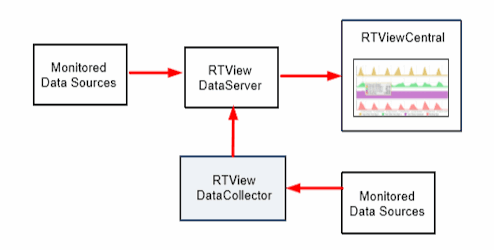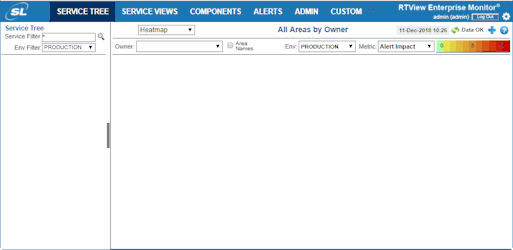Versions Compared
Key
- This line was added.
- This line was removed.
- Formatting was changed.
To deploy RTView EM On-premise you:
- Download, Install and Start RTViewCentral
- Download, Install and Setup RTView DataServer
- Optionally Setup RTViewCentral Features
RTView
EMEnterprise Components
RTView Enterprise Monitor Edition (the Monitor) is comprised of one or more RTView DataServers and a single RTViewCentral. The following figure illustrates the basic RTView Enterprise Monitor topology and the data flow from your monitored resources. The gray areas indicate the components currently being discussed.

The RTView DataServers collect and store performance data. RTViewCentral is comprised of displays that allow you to view performance data from the RTView DataServers, manage alerts against that data and integrate it into a Service Model.
RTViewCentral
RTViewCentral is where the metric data collected by the RTView DataServer is analyzed, correlated and transformed; historical data is aggregated; alert rules and actions are defined; and where the “master” mapping of everything monitored in your system resides.
RTViewCentral is where you configure optional features that extend, enhance or optimize your RTView Enterprise Monitor deployment. For example, you can configure the central databases, the service model, user and role management, high availability, alert features such as alert notification, and modify the Monitor user interface.
RTViewCentral is comprised of a Display Server, the Central Server, the Central Alert Historian and a database. RTViewCentral also has the RTView Manager and RTVRules data servers.
RTView DataServers
RTView DataServers collect data from your data sources and make them available for display and alerting. RTView DataServers are comprised of displays that you can add on to your RTView Enterprise Monitor system.

Solution Packages are bundled into RTView DataServers. For example, the RTView DataServer for TIBCO, which includes the Solution Packages for TIBCO EMS, BusinessWorks, and many other TIBCO applications.
RTView DataServers are also available for IBM, Infrastructure, Kafka, Oracle, Solace and RTView Manager. Performance data collected for these technologies are correlated with the displays that come with RTView Enterprise Monitor.
Distributed Deployments & RTView DataCollectors
Each RTView DataServer has a corresponding RTView DataCollector. The RTView DataCollector is useful for distributed deployments as they can be deployed to collect data from otherwise unreachable data sources and send the data to its RTView DataServer pair.

To Deploy the Monitor:
Do the following in the order provided to setup the Monitor.* The first two steps are required.
- Download, Install and Start RTViewCentral (so that you can see your data after connecting an RTView DataServer).
- Download, Install and Setup RTView DataServer (so that you can start collecting performance data from your system).
- Configure RTViewCentral (so that you can extend, enhance or optimize your Monitor deployment with features such as alert notifications, service model, the central database, user and role management, high availability and modify the Monitor user interface.
*If you currently have an RTView installation or need detailed instructions, refer to the RTView Enterprise Monitor Configuration Guide.
Download, Install and Start RTViewCentral
- Go to the SL Download Center at https://sl.flexnetoperations.com/, download and extract the RTViewCentral_<version>.zip file.
UNIX/Linux: The installation directory path must not contain spaces. Set the JAVA_HOME environment variable to the location of your Java installation.
Execute the start_servers.bat/sh script, located in the RTViewCentral/bin directory, to start RTView Enterprise Monitor.
Point a browser to http://localhost:10070/rtview-central-classic and login (admin/admin).
The RTView Enterprise Monitor opens to the SERVICE TREE tab All Areas by Owner display, by default.
The first time you open the Monitor displays are visible but not yet populated with monitoring data (as shown in the above figure). After you download and configure one or more RTView DataServers, configure data collection and integrate with RTView Enterprise Monitor, the displays populate with your monitoring data.
Download, Install and Setup RTView DataServer/DataCollector
Use the following links to download, install, connect, and setup EM Integration on one or more RTView DataServers/DataCollectors:
- Configure RTView DataServer/DataCollector for IBM
- Configure RTView DataServer/DataCollector for Infrastructure
- Configure RTView DataServer/DataCollector for Kafka
- Configure RTView DataServer/DataCollector for Oracle
- Configure RTView DataServer/DataCollector for TIBCO
- Configure RTView DataServer/DataCollector for Solace
Now you can optionally Configure RTViewCentral.
Optionally, Setup RTViewCentral Features
For detailed instructions, see the RTView Enterprise Monitor Configuration Guide.
| Table of Contents |
|---|